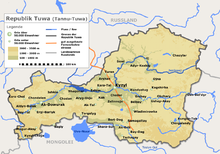User:Jwall1515/sandbox
[edit]
| Tuvan Autonomous Soviet Socialist Republic | |||||||||
|---|---|---|---|---|---|---|---|---|---|
| Autonomous Republic of Russian SFSR | |||||||||
| 1961–1992 | |||||||||
| Capital | Kyzyl | ||||||||
| • Type | Autonomous Soviet Socialist Republic | ||||||||
| History | |||||||||
• Established | 10 October 1961 | ||||||||
• Disestablished | 31 March 1992 | ||||||||
| |||||||||
The Tuvan Autonomous Soviet Socialist Republic (Russian: Тувинская Автономная Советская Социалистическая Республика; Tuvan: Тыва Автономнуг Совет Социалистиг Республика), or the Tuvan ASSR (Russian: Тувинская АССР; Tuvan: Тыва АССР), was an autonomous republic of the Russian SFSR. It was created on October 10, 1961 from the Tuvan Autonomous Oblast.[1] Its territory measured 175,000 square Kilometers and bordered Mongolia to the south, Buryat ASSR to the east, Altai Krai to the west and Krasnoyarsk Krai to the north.[2] The Tuvan ASSR was awarded the Order Of Lenin on Oct. 9, 1964 to commemorate its 20th anniversary of its incorporation into the Soviet Union, as well as the Order of Friendship of Peoples on Dec. 29, 1972 to honor the 50th anniversary of the USSR.[3] The highest organ of government in the Tuvan ASSR was the Supreme Soviet of the Tuvan ASSR, made up of 130 deputies on 5 year terms.[4]
Economics of the Tuvan A.S.S.R.[edit]
The Tuvan Autonomous Soviet Socialist Republic’s economy was mostly composed of two primary sectors, agriculture and mineral extraction, its principal crops were wheat and barley.[5] In contrast to largely indigenous agriculture, Tuvan industry was largely fueled by Russian immigrant labour.[6]
Ethnic-Makeup of the Tuvan A.S.S.R.[edit]
Despite Russian immigration and the education system both secondary and post-secondary being carried out almost exclusively in Russian by the 1990s, Tuvans remained the largest ethnicity in Tuva (approximately 206,000 residents were of Tuvan ethnicity, and 98,000 were of Russian ethnicity in 1990 .[7] For much of its existence, The Tuvan Autonomous Soviet Socialist Republic was home to numerous prison camps as well as labor colonies.[8]
Ethnic Clashes[edit]
1990 saw the beginning of ethnic clashes between minority Russians and majority Tuvans, although according to Toomas Alatalu, the magnitude of these attacks were largely exaggerated by the Russian media.[9] This came as a result of numerous policies alienating the indigenous population in favor of the minority Russian population, such as the policy of the compulsory admittance of sons of cattle-raisers' children to Russian boarding schools.[10]
The 1990 Tuvan Elections and the 1991 Russian Federal Election[edit]
Despite ethnic tensions, according to Estonian politician and writer Toomas Alatalu, Tuva had become a bastion of Soviet Conservatism fueled by the strong partocracy which had grown within the small republic. The Tuvan elections of 1990 was the first time since the incorporation of Tuva into the USSR that all three positions of power within the Tuvan administration were held by ethnic Tuvans. The 1991 Russian presidential election saw Tuva being one of the few autonomous republics to overwhelmingly vote for the Communist Party candidate Nikolai Ryzhkov, with 65% of the vote going to Ryzhkov and 15% for Boris Yeltsin.[11] In 1991 a democratic coalition of forces, including youth leaders and intellectuals, initiated a hunger strike on August 27, demanding the resignation of the republic’s leadership. On August 28, a meeting of Parliament was called, where Chimit-Dorzhu Ondar, then Chairman of the Supreme Soviet, resigned, and all property of the Communist Party was absorbed by the government.[12] This action led to the dissolution of the Tuvan Autonomous Soviet Socialist Republic.
On March 31, 1992, its successor, the Tuva Republic, became a constituent member of the Russian Federation.
See also[edit]
Notes[edit]
- ^ Keesing's Contemporary Archives Volume 7, (October, 1961) p. 18377
- ^ Mongush, Mergen. “The Annexation of Tannu‐Tuva and the Formation of the Tuva ASSR.” Central Asian Survey 12, no. 1 (1993): 81–85. https://doi.org/10.1080/02634939308400802. p.81
- ^ The Great Soviet Encyclopedia, 3rd Edition. S.v. "Tuva Autonomous Soviet Socialist Republic."
- ^ ibid.
- ^ ibid.
- ^ Alatalu, Toomas. “Tuva—A State Reawakens.” Soviet Studies 44, no. 5 (1992): 881–95. https://doi.org/10.1080/09668139208412051. p.890
- ^ Ibid.890
- ^ Ibid.890
- ^ Ibid.890
- ^ Ibid.890
- ^ Ibid.890
- ^ Ibid.893

Category:Autonomous republics of the Soviet Union Category:1992 disestablishments Category:States and territories established in 1961 Category:History of Tuva



